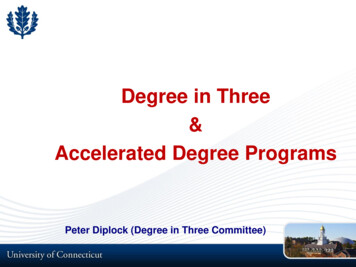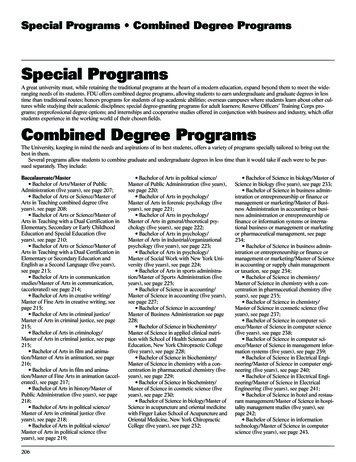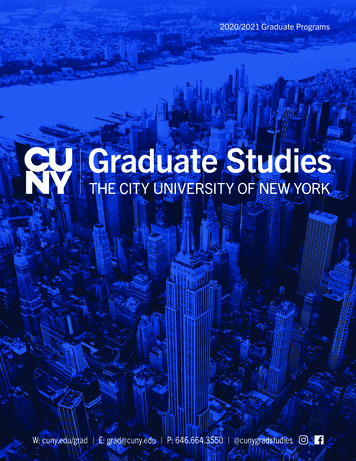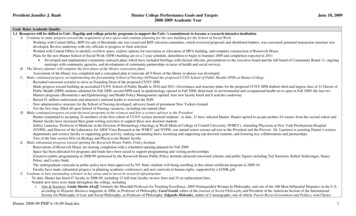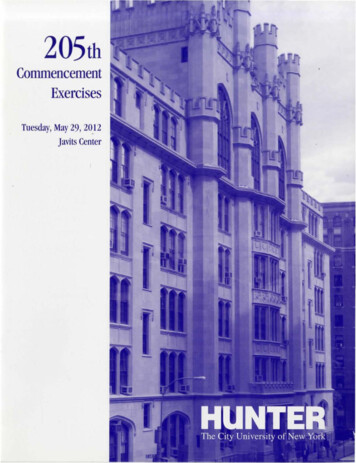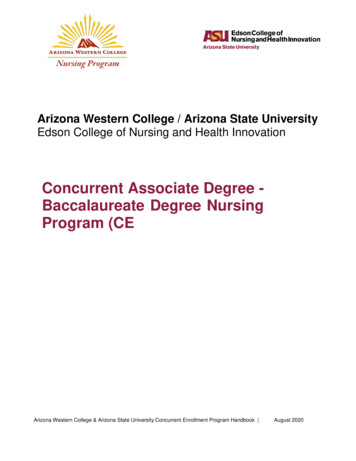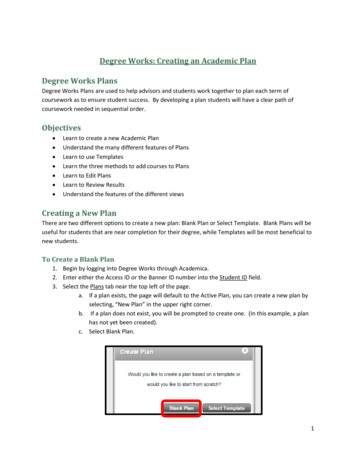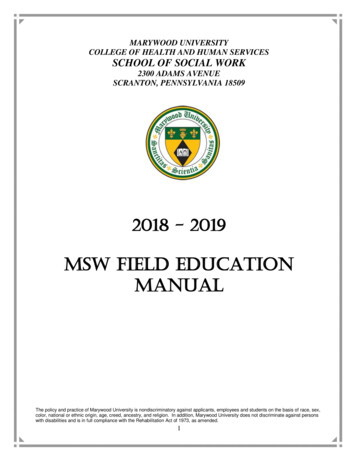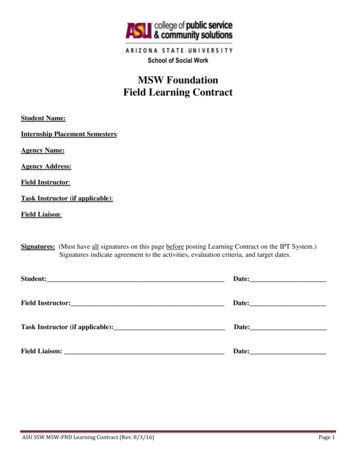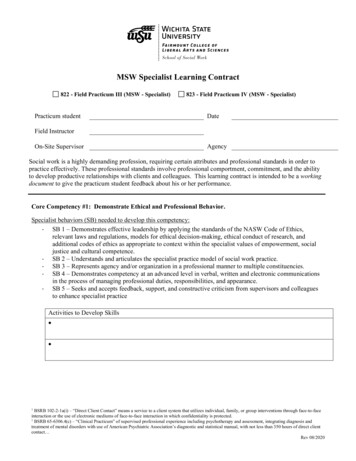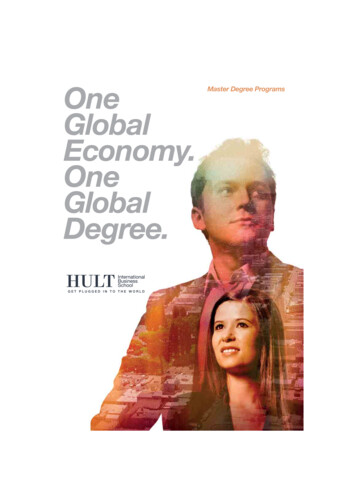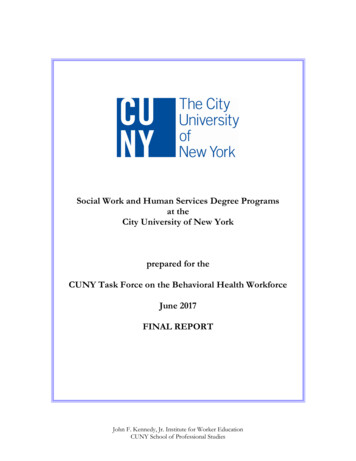
Transcription
Social Work and Human Services Degree Programsat theCity University of New Yorkprepared for theCUNY Task Force on the Behavioral Health WorkforceJune 2017FINAL REPORTJohn F. Kennedy, Jr. Institute for Worker EducationCUNY School of Professional Studies
Social Work and Human Services Programs at CUNYJune 2017Table of ContentsINTRODUCTION . 5CUNY MSW DEGREE PROGRAMS . 10Demographics of MSW Graduates at Hunter and Lehman . 10Graduation Rates of Students in CUNY MSW Programs . 11Licensure of CUNY MSW Graduates . 12Different Demographics and Post-Graduate Outcomes for Students in Hunter’s Full-Timevs. One-Year Residency MSW Options . 13Demographics of Hunter MSW Graduates by Program Type . 14Graduation Rates of Students in Hunter’s MSW Program . 14Licensure of Hunter MSW Graduates by Program Type . 16Employers of Hunter MSW Graduates . 17Earnings of Hunter MSW Graduates . 18Prior CUNY Bachelor’s Degrees of CUNY MSW Graduates . 19BACCALAUREATE DEGREES IN SOCIAL WORK (SW) AND HUMAN SERVICES(HS) . 21Baccalaureate Social Work and Human Services Graduates .Demographics of Baccalaureate SW and HS Graduates .Earnings of CUNY Baccalaureate SW and HS Graduates.CUNY Master’s Enrollment of CUNY Baccalaureate SW and HS Graduates .21212324CUNY ASSOCIATE HUMAN SERVICES PROGRAMS . 26CUNY Associate Human Services Graduates .Demographics of Associate Human Services Graduates .Earnings of CUNY Associate Human Services Graduates .CUNY Bachelor’s Enrollment of CUNY Associate Human Services Graduates .26262829DISCUSSION . 31RECOMMENDATIONS . 37REFERENCES . 38City University of New York1
Social Work and Human Services Programs at CUNYJune 2017List of TablesTable 1.CUNY MSW Graduates, by College, 2006-07 to 2015-16 . 10Table 2.Gender and Age of CUNY MSW Graduates, 2006-07 to 2015-16 . 11Table 3.Licensed Master Social Workers (LMSW) as of May 2016, CUNY MSW Graduates2004-05 to 2012-13 . 12Table 4.Licensed Clinical Social Workers (LCSW) as of May 2016, CUNY MSW Graduates2005-06 to 2010-11 . 13Table 5.Gender and Age of Hunter MSW Graduates by Program Type, 2005-06 to 2012-13 14Table 6.Licensed Master Social Workers (LMSW) as of May 2016, Hunter Graduates 200506 to 2012-13 . 16Table 7.Licensed Clinical Social Workers (LCSW) as of May 2016, Hunter MSW Graduates2005-06 to 2010-11 . 17Table 8.Top 20 Employers of Hunter MSW Graduates as of Q3 2013 . 18Table 9.Percent of CUNY MSW Graduates with Prior CUNY Bachelor’s Degree, by MSWProgram and Year of MSW Degree, 2005-06 to 2015-16 . 19Table 10. CUNY Bachelor’s Degree College of CUNY MSW Graduates, by MSW Program,2005-06 to 2015-16 . 20Table 11. CUNY Bachelor’s Degree Majors of CUNY MSW Graduates, by MSW Program,2005-06 to 2015-16 . 20Table 12. CUNY Baccalaureate SW and HS Graduates, by College, 2006-07 to 2015-16 . 21Table 13. Gender and Age of CUNY Baccalaureate SW and HS Graduates, 2006-07 to 2015-16. 23Table 14. Percent of CUNY Baccalaureate SW and HS Graduates Subsequently Enrolling in aCUNY Master’s Program, by College and Year Graduated . 24Table 15. Type of Master’s Program Enrolled in, CUNY Baccalaureate SW and HS Graduates. 24Table 16. Percent of CUNY Baccalaureate SW and HS Graduates Subsequently Enrolling in aCUNY MSW Program, by College and Year Graduated . 24Table 17. MSW Program Attended, for CUNY Baccalaureate SW and HS GraduatesSubsequently Enrolling in an MSW Program . 25Table 18. CUNY Associate Human Services Graduates, by College, 2006-07 to 2015-16 . 26City University of New York2
Social Work and Human Services Programs at CUNYJune 2017Table 19. Gender and Age of CUNY Associate Human Services Graduates, 2006-07 to 2015-16. 28Table 20. Percent of CUNY Associate Human Services Graduates Subsequently Enrolling in aCUNY Bachelor’s Program, by College and Year Graduated . 29Table 21. Type of Bachelor’s Program Enrolled in, CUNY Associate Human ServicesGraduates . 29Table 22. Bachelor’s College Enrolled in, CUNY Associate Human Services Graduates . 30City University of New York3
Social Work and Human Services Programs at CUNYJune 2017List of FiguresFigure 1. CUNY MSW Graduates by Ethnicity, 2006-07 to 2015-16 . 10Figure 2. Percent of Students Graduating from CUNY MSW Programs Within Three YearsAfter their First MSW Course, 2005-06 to 2012-13 . 11Figure 3. Hunter MSW Degree Graduates by Program Type, 2005-06 to 2012-13 . 13Figure 4. Ethnicity of Hunter MSW by Program Type, 2005-06 to 2012-13 . 14Figure 5. Percent of Students Graduating from Hunter MSW Programs Within Three YearsAfter their First MSW Course, 2005-06 to 2012-13 . 15Figure 6. Percent of Students Graduating from Hunter MSW Programs Within Three YearsAfter their First MSW Course, by Race/Ethnicity, 2005-06 to 2012-13 . 15Figure 7. Median Total Annual Wages of Hunter MSW Graduates (Academic Years 2005-06 to2007-08) Employed in New York State, Five Years Before and After Graduation, byProgram Type, in Inflation-Adjusted 2013 Dollars . 19Figure 8. CUNY Baccalaureate SW and HS Graduates by Ethnicity, 2006-07 to 2015-16 . 22Figure 9. CUNY Baccalaureate SW and HS Graduates by Ethnicity, by College, 2006-07 to2015-16 . 22Figure 10. Median Total Annual Wages of CUNY Baccalaureate SW and HS Graduates(Academic Years 2005-06 to 2007-08) Employed in New York State, Five YearsBefore and After Graduation, in Inflation-Adjusted 2013 Dollars . 23Figure 11. CUNY Associate Human Services Graduates by Ethnicity, 2006-07 to 2015-16 . 27Figure 12. CUNY Associate Human Services Graduates by Ethnicity, by College, 2006-07 to2015-16 . 27Figure 13. Median Total Annual Wages of CUNY Associate Human Services Graduates(Academic Years 2005-06 to 2007-08) Employed in New York State, Five YearsBefore and After Graduation, in Inflation-Adjusted 2013 Dollars . 28City University of New York4
Social Work and Human Services Programs at CUNYJune 2017INTRODUCTIONA CUNY-wide Task Force on the Behavioral Health Workforce, was convened by ExecutiveVice Chancellor Vita Rabinowitz in October 2016. Behavioral Health (BH) a term thatencompasses both mental health and substance use disorders is at the center of healthcare reform,nationally and in New York. The purpose of the Task Force is to identify priorities and initiateprojects that will strengthen CUNY’s educational offerings in this professional practice area.It is CUNY’s responsibility to prepare qualified personnel to provide prevention and/or treatmentservices to NYC residents with BH conditions. To fulfill this mandate it offers graduate degreeprograms in most of the Health Resources and Services Administration’s (HRSA) federallydesignated “core mental health professions” including Clinical Social Work, Mental HealthCounseling, Clinical Psychology and Psychiatric Nurse Practitioner.i CUNY also offers a varietyof other graduate and undergraduate degrees and certificate programs that prepare licensed andunlicensed personnel to enter the BH field and provide opportunities for career advancement forincumbent workers who are already employed in this sector.In 2015 the Substance Abuse and Mental Health Services Administration (SAMHSA) funded aBehavioral Health Workforce Research Center (BHWRC) at the University of Michigan. Itsmission is to inform efforts by states and localities to strengthen their workforce responsible forthe prevention and treatment of mental health and substance use disorders. According to theBHWRC nearly 20% of the United States population lives with a BH condition. It cites agrowing body of research that integrating primary and behavioral care using a team-basedworkforce model, improves patient outcomes, decreases costs and increases staff productivity.Social workers are the largest group of clinically trained mental health providers. The BHWRCis charged with identifying the various roles that social workers play on integrated care teams,and will make recommendations on how curriculums can be modified to better prepare socialwork students and practitioners to deliver cost-effective services.iiConsistent with the national trend, the integration of BH services into primary care settings is acore strategy of Medicaid reform in NYS. In 2013, annual NYS Medicaid funding was almostCity University of New York5
Social Work and Human Services Programs at CUNYJune 2017 50 billion, and covered 5.8 million residents. Medicaid recipients diagnosed with BH conditionsaccounted for 21% of all recipients, but 60% of the total cost of care. In 2014, the Centers forMedicare and Medicaid Services (CMS) approved New York’s Medicaid Redesign Team (MRT)waiver amendment. The goal of the Delivery System Reform Incentive Payment (DSRIP)federal waiver is to reduce avoidable hospitalizations by transforming the healthcare deliverysystem and also the way that healthcare is paid for. To receive funding DSRIP required Medicaidproviders and community-based organizations to form networks called Performing ProviderSystems (PPSs). Twenty-five PPSs were funded statewide and of these eleven cover NYC’s fiveboroughs. All PPSs were required to use evidence-based best practices to integrate BH servicesinto primary care. Their future funding is contingent on the success of their efforts as measuredby patient outcomes. Since transforming the healthcare delivery system requires transforming theworkforce, DSRIP awarded funds to PPSs to recruit new staff, and retrain and re-deployincumbent workers.iiiAccording to the NYS Office of the Professions, as of January 2017, there were 11,847 LicensedMaster Social Workers (LMSWs) and 10,531 Licensed Clinical Social Workers (LCSWs)residing in NYC. The LCSW provides clinical services such as the diagnosis of mental,emotional, behavioral, developmental, and addictive disorders, the development of treatmentplans, and psychotherapy. The LMSW may provide these clinical services but only under thesupervision of a LCSW, licensed psychologist or psychiatrist.iv There is a strong local demandfor LMSWs and LCSWs. For example, an analysis conducted for One City Health, the NYCHealth Hospitals led PPS, determined that over the next four years, just in its project tointegrate primary care and behavioral health, it would need to hire an additional 139 LCSWs.There is a strong demand for LCSWs because they practice at the top of their professionallicense, their services can be reimbursed, they can supervise and mentor LMSWs, and they canplay a leadership role in changing the culture of the organization. One City Health will also needadditional generalist level LMSWs as part of a cadre of multi-disciplinary team leaders acrossseveral behavioral health initiatives.v Other NYC-based PPSs such as Montefiore, NYULutheran, Maimonides, and St. Barnabas have reported high vacancy rates for LMSWs and/orLCSWs.viCity University of New York6
Social Work and Human Services Programs at CUNYJune 2017In addition, New York has sponsored the development of Health Homes, models of coordinatedcare between medical and social support networks, to provide intensive case management toMedicaid beneficiaries who have a chronic medical condition and/or a mental health orsubstance use diagnosis. Medicaid beneficiaries at the highest risk of avoidable hospital use arethose who are eligible for Health Homes. Among the most preferred educational requirementsfor Care Managers in Health Homes and other team-based models of care is the Bachelor’s inSocial Work. Multi-disciplinary team members usually have a range of life experiences andlevels of formal education. Licensed professionals may include LMSWs, LCSWs, Psychiatrists,Nurses and Nurse Practitioners, Psychologists and Mental Health Counselors. In addition tobaccalaureate level Social Workers as Care Managers, community health workers, peers, andparaprofessionals such as patient navigators, medical assistants and health coaches are valuedmembers of the emerging behavioral health workforce.At its best, the integrated care team has a collective identity and shared responsibility for a groupof patients. It provides a collaborative context in which assistive health personnel can assumegreater responsibility in the delivery of services. A less hierarchal structure can facilitatecommunication and increase the likelihood that each team member will be respected. There issubstantial evidence that with appropriate training and supervision assistive health personnel cancontribute to quality outcomes by helping underserved populations navigate a fragmenteddelivery system. Their first-hand knowledge of the community and their cultural and linguisticdiversity make them great assets in team-based models of care.viiOngoing health care reform will require a more sophisticated frontline staff with a broader scopeof responsibility and practice. Thus, there is a need to provide professional development, careeradvancement opportunities, and access to higher education, for dedicated and motivatedpersonnel that have the experience and skills to deliver clinical and social services to people inthe community who are living with BH conditions. Thirteen CUNY colleges offer degreeprograms in Social Work or Human Services, ranging from the Associate level to the Doctorate.As a consortium, the following programs provide a network of career ladders for students whoare interested in entering these disciplines, and for practitioners who want to advance in theirchosen field:City University of New York7
Social Work and Human Services Programs at CUNYJune 2017Silberman School of Social Work at Hunter College offers the MSW and BSW.Lehman College offers the MSW and BA in Social Work.College of Staten Island (CSI) offers the MSW and BS in Social Work.York College offers the MSW (pending) and BS in Social Work.Medgar Evers College (MEC) offers the BS in Social Work.New York City College of Technology (NYCCT) offers the BS and AAS in HumanServices.John Jay College offers the BS in Human Services and Community Justice (pending).Bronx Community College (BCC) offers the AAS in Human Services.Borough of Manhattan Community College (BMCC) offers the AS in Human Services.Kingsborough Community College (KBCC) offers the AS in Mental Health and HumanServices and the AS in Substance Abuse Counseling.LaGuardia Community College (LGCC) offers the AA in Human Services.Guttman Community College offers the AA in Human Services.The CUNY Graduate School offers the Ph.D. in Social Welfare.The following report on graduation rates, demographics, career pathways, licensure, employmentand wages of graduates of CUNY’s Social Work and Human Services degree programs wasprepared as a resource for the CUNY Task Force on the Behavioral Health Workforce. Itintegrates data from CUNY’s Institutional Research Database (IRDB), the NYS Department ofLabor Unemployment Insurance (UI) wage record files and the NYS Office of the Professionsdatabase of licensed professionals, the primary source for license verification.CUNY’s IRDB is a warehouse of CUNY’s official student data, combining information from allthe colleges in a single relational database. The IRDB contains detailed enrollment, graduation,and course data for all CUNY students from 1990 to the present. The NYS UI wage record filesCity University of New York8
Social Work and Human Services Programs at CUNYJune 2017provide individual quarterly wage data and employer names and industry classification for thoseemployed in NYS, excluding federal employees and self-employed. The UI wage record datafrom 1996 to 2013 has been linked with CUNY’s enrollment data.This JFK, Jr. Institute for Worker Education report was prepared by Senior Research AssociateTravis Dale, Senior Fellow Dr. William Ebenstein, and Institute Director, Dr. Carrie Shockley.We want to thank Behavioral Health Workforce Task Force members, Evan Senreich, AssociateProfessor of Social Work at Lehman College, Daniel Herman, Professor of Social Work at theSilberman School of Social Work at Hunter College, and Curtis Dann-Messier, AssistantDirector for Continuing Education in the CUNY Central Office of Academic Affairs, for theirvaluable feedback on drafts of this report.City University of New York9
Social Work and Human Services Programs at CUNYJune 2017CUNY MSW DEGREE PROGRAMSIn 2015-16, three schools offered the MSW: The Silberman School of Social Work at HunterCollege, Lehman College and the College of Staten Island (CSI). Graduates are eligible forlicensure through the NYS Office of the Professions as LMSWs and LCSWs. From 2006-07through 2015-16 the number of CUNY MSW graduates nearly doubled from 330 to 625.Table 1.CUNY MSW Graduates, by College, 2006-07 to 2011201120122012201320132014201
Social Work and Human Services Programs at CUNY June 2017 City University of New York 2 List of Tables Table 1. CUNY MSW Graduates, by College, 2006-07 to 2015-16 . 10 Table 2. Gender and Age of CUNY
